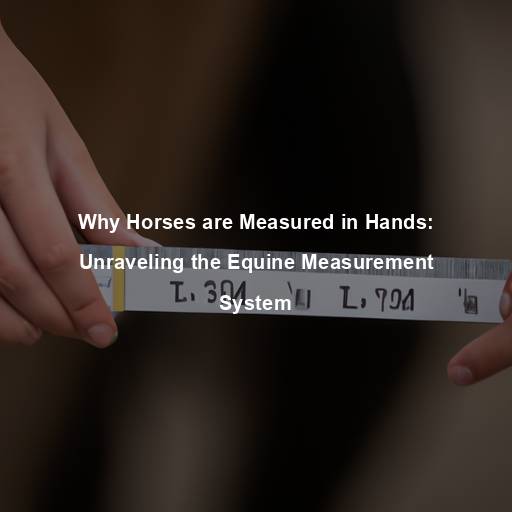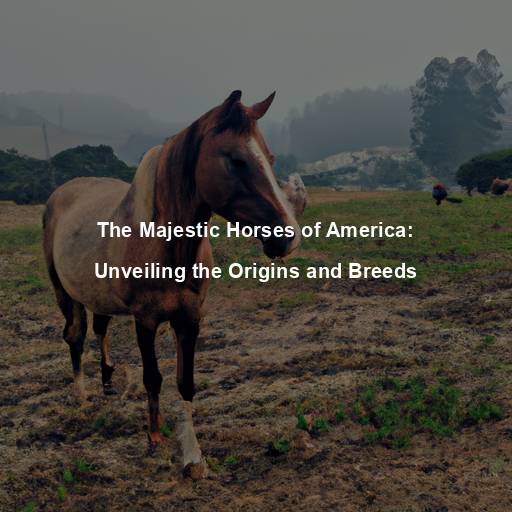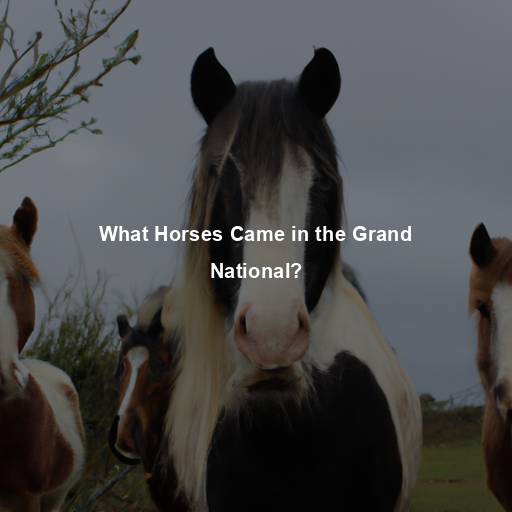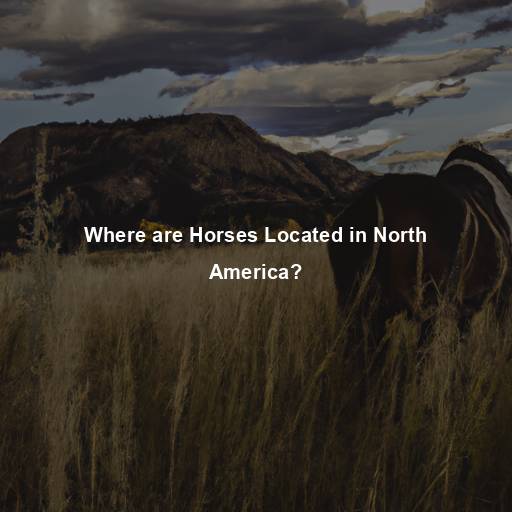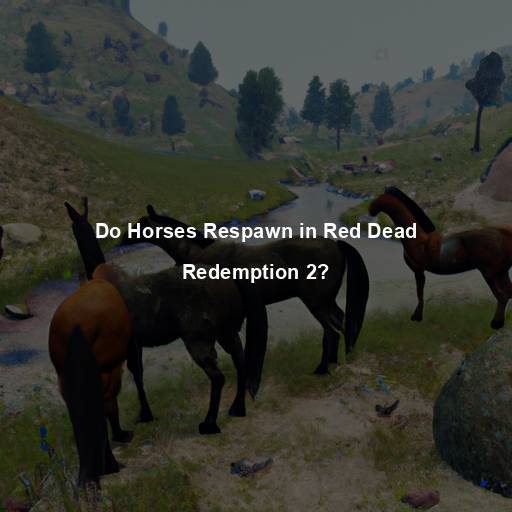Why Horses are Measured in Hands: Unraveling the Equine Measurement System
Last Updated on July 31, 2023 by Evan
Contents
- 1 Defining the Equine Measurement System
- 2 Understanding the Significance of Hands
- 3 How to Measure a Horse in Hands
- 4 The Advantages of Measuring in Hands
- 5 Common Misconceptions
- 6 The Cultural Significance of Hands
- 7 The Future of Equine Measurement
- 8 The Beauty of Equine Diversity
- 9 Celebrating the Equine Spirit
- 10 The Hands Measurement: Limitations and Considerations
- 11 Cultural Influences on Equine Measurement
- 12 The Human Connection: Bridging the Gap
- 13 The Legacy of Hands: Preserving Tradition
- 14 Embracing the Future
- 15 FAQs: Why Horses are Measured in Hands
- 15.1 What does it mean to measure a horse in hands?
- 15.2 Why are horses measured in hands and not other units?
- 15.3 How accurate is measuring a horse in hands?
- 15.4 Are there any advantages to using hands as a measurement unit?
- 15.5 Do all countries measure horses in hands?
- 15.6 Are there any alternative methods to measuring horses’ height?
- 15.7 Is there a specific way to measure a horse in hands?
Defining the Equine Measurement System
For centuries, horses have held a captivating aura that has enchanted humans. Their height, however, is measured in a way that sets them apart from other animals. Instead of the conventional units like feet or meters, horses are measured in “hands”. But why this peculiar system?
The Origin of the Hand
Have you ever wondered why horses are measured in hands? Well, let’s dive into the fascinating world of ancient civilizations to uncover the perplexing origins of this peculiar practice. Our journey takes us all the way back to the enigmatic land of ancient Egypt, where the concept of the hand as a unit of measurement emerged. It was a time when humanity sought to unravel the mysteries of the universe, and in their quest for knowledge, they found a clever way to measure the height of magnificent horses.
The Evolution of Equine Measurement
As time progressed, the use of hands as a measurement unit for horses spread beyond ancient Egypt. It became a standardized way of measuring equine height across different cultures. Over the centuries, the equine measurement system has remained remarkably consistent, with a single hand being equivalent to four inches or ten centimeters.
Understanding the Significance of Hands
Anatomical Proportions
Have you ever wondered how horse enthusiasts accurately measure the height of these majestic creatures? Well, let me introduce you to the fascinating equine measurement system known as “hands”. Derived from the intricate anatomical proportions of horses, this system not only provides a practical means of determining a horse’s height but also plays a critical role in a multitude of equine endeavors, including breeding, racing, and showing. So, buckle up, because we’re about to embark on a journey into the enigmatic world of equine measurements, where numbers and proportions intertwine to unveil the true stature of these magnificent animals.
Consistency and Tradition
The use of hands as a measurement unit for horses has stood the test of time due to its consistency and tradition. It has become deeply ingrained in the equestrian world, with everyone from breeders to riders using hands to communicate and understand the size and stature of horses.
How to Measure a Horse in Hands
The Vertical Measurement
To measure a horse in hands, the height is determined vertically from the ground to the highest point of the withers, which is the ridge between the horse’s shoulder blades. A measuring stick or a measuring tape can be used to obtain an accurate measurement. The horse should stand on a level surface and be relaxed for an accurate reading.
Recording the Measurement
When it comes to determining the height of a horse, things can get a bit perplexing. You see, this measurement is recorded in something called “hands,” which represent four inches or ten centimeters. So, picture this: if a horse measures 15 hands, that’s like saying it stands at a towering 60 inches or 152 centimeters. But here’s the kicker – if the measurement falls between two whole numbers, it’s often rounded up to the nearest whole hand.
The Advantages of Measuring in Hands
Universality and Consistency
The sheer brilliance of measuring horses in hands lies in its remarkable universality. This equine measurement system, woven into the fabric of equestrian essence, transcends borders and language barriers with ease. Its splendid universal recognition grants us harmonious communication and unparalleled comparisons, reaffirming the grandeur of horse heights in disparate domains and regions. Oh, how the world marvels at this majestic and unifying notion!
Simplicity and Practicality
One of the most fascinating aspects of the equestrian world is the intricate way in which we measure the height of our majestic companions. Gone are the days of convoluted conversions and perplexing calculations. With the revolutionary hands system, horse owners, trainers, and riders can now embark on a straightforward journey of assessing and delving into the enigmatic realm of horse size. This innovative method not only simplifies the process but also ignites a burst of excitement within the equine community, as discussions about our magnificent steeds reach new levels of dynamism and intrigue.
Tradition and Cultural Significance
Beyond its practicality, the equine measurement system holds significant cultural and historical value. It serves as a reminder of our deep connection with horses throughout human history and preserves the traditions and customs associated with equestrianism.
Common Misconceptions
Hand Size Variation
There seems to be a captivating misconception floating around regarding the measurement of a hand. Let me clear the air and unveil the truth behind this perplexing topic. It turns out that despite our assumptions, the size of an individual’s hand does not impact the measurement itself. In fact, the hand remains a steadfast unit of measurement, locked at a standard of four inches or ten centimeters.
Metric Conversion
While the equine measurement system is primarily based on the imperial unit of inches, metric conversions are widely used and accepted in equestrian communities around the world. This allows for seamless communication and understanding between individuals who prefer the metric system and those who adhere to the traditional hands measurement.
The Role of Breed Standards
Horses, majestic creatures that they are, possess a fascinating dimension in the form of breed standards. These standards, an intricate tapestry woven into the equine measurement system, delineate the height requirements specific to each horse breed. Throughout the realm of horses, these standards serve as guardians of uniformity and consistency, forging a common path for breeders and owners to traverse. Through these guidelines, the enigmatic realm of horse assessment and selection, whether for breeding or competition, is infused with a sense of purpose and clarity.
Height Classifications
Horses are often categorized into different height classifications based on the hands measurement. These classifications can vary depending on the discipline or breed. For example, in show jumping, horses may compete in different height divisions, such as pony, small horse, medium horse, and large horse. The hands measurement helps ensure fair competition within each height category.
Factors Affecting Horse Height
When it comes to the size of horses, one should tread through a landscape of variable factors with caution. Much like an intricate tapestry, genetics, nutrition, age, and overall health play a hand in determining the majestic stature of these four-legged beings. However, let us not forget the perfidious influence of environmental characteristics, like the nature of terrain and the intensity of exercise. In this perplexing web, it is vital to weave together all these intricate threads to truly comprehend a horse’s dimensions and potential growth.
The Cultural Significance of Hands
Historical Symbolism
The use of hands as a measurement unit for horses goes beyond its practicality. It carries historical symbolism and cultural significance, representing the deep bond between humans and horses throughout the ages. Horses have been integral to human society, serving as companions, working animals, and even symbols of power and prestige. The measurement of horses in hands preserves this rich history and connects us to our equestrian heritage.
Equestrian Terminology
The equine measurement system using hands has also influenced the terminology used in the equestrian world. Phrases such as “hands high” and “hands at the withers” have become an integral part of equestrian vocabulary. This shared language allows horse enthusiasts, regardless of their geographic location, to communicate effectively and precisely when discussing horse height and size.
The Future of Equine Measurement
While the hands measurement system has stood the test of time, evolving technologies and advancements in the equine industry may bring about changes in how we measure horses in the future. New devices, such as laser sensors and digital imaging, offer potential alternatives to traditional measuring techniques. These innovations could provide more accurate and efficient ways to determine equine height.
Standardization and Modernization
Efforts are underway to standardize and modernize the equine measurement process. This includes the development of digital databases and online platforms where horse owners and breeders can record and access height measurements. These advancements aim to streamline the measurement process, improve accuracy, and facilitate data sharing within the equestrian community.
Embracing Innovation
For centuries, horse lovers have relied on the tried-and-true method of measuring these majestic creatures with their hands. But in this era of endless possibilities, it’s high time we start thinking outside the stable. By embracing new technologies and forging innovative paths, we can unlock a whole new world of accuracy, transparency, and growth for the equine industry. So saddle up and get ready to ride the wave of change – because there’s no telling how far we can go when we challenge convention and explore uncharted territories.
The Beauty of Equine Diversity
One of the remarkable aspects of the equine world is the incredible diversity of horse breeds. Each breed possesses unique characteristics, including size, conformation, and temperament. The hands measurement system allows us to appreciate and celebrate this diversity by providing a standardized way to assess and compare horses of different breeds and sizes.
Small but Mighty
Discover the marvels of the equine kingdom as we delve into the world of petite powerhouses. From the spirited Icelandic horse to the charismatic Shetland pony, these smaller breeds may be vertically challenged, but their determination and tenacity are nothing short of extraordinary. Don’t let their size fool you – these mighty equines have conquered a variety of disciplines and proven time and time again that greatness comes in all shapes and forms. Prepare to be captivated by their boundless vigour and astonishing adaptability, truly showcasing the awe-inspiring nature of these remarkable species.
The Majesty of Giants
In the incredible realm of horse breeds, there exists a captivating troop of majestic equines blessed with remarkable tallness. Behold the awe-inspiring Shire and Percheron breeds, whose towering stature beckons the curious at heart. Through the mystical hands measurement system, we are granted a glimpse into the realm of grandeur these magnificent creatures occupy, leaving us astounded by their formidable dominance in the animal kingdom. Prepare to be spellbound by their majestic presence!
Celebrating the Equine Spirit
Discover the enigmatic allure of horses and the captivating world of hands measurements. Beyond mere practicality, this ancient system weaves a tapestry of equine enchantment, celebrating the boundless spirit of these magnificent creatures. Through the annals of human history, horses have left an indelible mark, igniting our hearts with their majestic presence. From the canvases of master artists to the pages of literature, they have fueled our imagination and sparked a deep appreciation for their effortless grace.
A Language of Love
Whether you are a seasoned equestrian, a horse enthusiast, or simply someone who appreciates the beauty of these creatures, the equine measurement system using hands unites us with a shared language of love and admiration. It allows us to communicate and connect on a deeper level, transcending borders and cultures.
The Magic of Horses
In conclusion, the measurement of horses in hands is a testament to the enduring bond between humans and horses. It is a reflection of our fascination and reverence for these magnificent animals. As we continue to appreciate and celebrate the equine world, let us remember the profound significance of hands and the stories they tell about the magic of horses. ## The Equine Measurement System: A Window into Horse Anatomy
Understanding Proportions
The equine measurement system using hands provides valuable insights into the proportions and conformation of horses. By measuring a horse’s height at the withers, we can assess its overall body structure and determine its suitability for specific disciplines or tasks.
Conformation and Performance
When it comes to horses, conformation is the whole package: their bones, muscles, and overall physique. The hands measurement system is a handy tool that helps us assess the proportions of their various body parts, like the neck, back, and legs. It’s all about finding that sweet spot of balance, movement, and athleticism for our equine companions.
Ideal Proportions
While there is no definitive “perfect” conformation, certain proportions are generally considered desirable for various disciplines. For example, in the sport of dressage, horses with well-balanced proportions and a harmonious body structure are sought after for their ability to perform precise and controlled movements.
The Hands Measurement: Limitations and Considerations
Variations within Breeds
When it comes to determining a horse’s height, the hands measurement system is widely accepted as the go-to method. However, it’s crucial to understand that even within a particular breed, there can be a range of heights. Various factors like genetics, nutrition, and individual development can throw a captivating twist into the mix, making each horse a unique case of equine puzzle. So, while we can rely on the hands system for some level of consistency, the perplexing reality remains that not all horses within a breed will march to the same height drumbeat.
Growth and Development
Just like humans, horses experience a remarkable journey of growth and development. These majestic creatures begin their lives as tiny foals, gradually blossoming into towering beings. However, it’s important to note that relying solely on a horse’s hands measurement may not provide an accurate reflection of its ultimate adult height. To truly understand a horse’s potential growth, breeders and owners must carefully take into account their age and specific developmental stage.
Skeletal Differences
While the hands measurement system provides a useful tool for assessing overall height, it does not account for variations in skeletal structure. Horses with longer necks or longer legs may appear taller or shorter than their actual height in hands. It is essential to consider the entire body structure and proportions when evaluating a horse’s conformation.
Cultural Influences on Equine Measurement
Discipline-Specific Measurements
Certain equestrian disciplines have specific measurement requirements and height restrictions. For example, in eventing, horses must meet certain height criteria to compete in different levels, ensuring fair competition and maintaining safety standards. Understanding the discipline-specific measurement regulations is essential for riders, trainers, and organizers.
The Human Connection: Bridging the Gap
Establishing Trust and Understanding
Exploring the dimensions of horses through the intriguing concept of hands not only offers a profound glimpse into their magnificent stature, but also facilitates a profound sense of connection between humans and these captivating creatures. By delving into the realm of measurement and comprehending horses using a universally accepted system, we forge a bond built on trust and pave the way for seamless communication in an array of equine pursuits. Through this kaleidoscope of knowledge, we unravel the secrets of these majestic beings, creating a harmonious symphony of partnership and understanding.
Appreciating the Beauty of Diversity
Welcome to the captivating world of equines, where the measurement system of hands unravels a tapestry of diversity. From the graceful Arabian horse with its exquisite features to the mighty Clydesdale exuding strength, every breed brings its own enigmatic allure to the equine realm. Together, we embark on a journey that celebrates the multifaceted qualities and intricate contributions, reminding us of the pressing need to safeguard and cherish these extraordinary creatures.
The Legacy of Hands: Preserving Tradition
Historical Continuity
Throughout the sprawling tapestry of time, the hands measurement system stands as a sacred relic, weaving connections between past and present. Its delicate threads bind us to a realm suffused with the essence of equine passion, where horse lovers have quenched their curiosity for countless ages. With each gentle embrace of this age-old tradition, we tenderly cradle the accumulated lore and sagacity bequeathed to us by the equestrian pioneers who came before.
Cultural Heritage
The equine measurement system using hands is an integral part of our cultural heritage. It symbolizes our deep-rooted relationship with horses and the profound impact they have had on human civilization. By upholding this tradition, we ensure that future generations can appreciate and understand the historical significance of measuring horses in hands.
Embracing the Future
In the ever-evolving equestrian realm, the significance of the traditional hands measurement system cannot be denied. Yet, amidst this steadfast tradition, it is essential to welcome the enigmatic allure of the future. With technological breakthroughs and groundbreaking revelations about equine anatomy on the horizon, a new era of measurement techniques and tools may one day grace our equine world. These remarkable innovations hold tremendous promise, offering the tantalizing prospect of impeccable precision, seamless efficiency, and the deepening of our understanding of the enigmatic science that surrounds our equine companions.
Embracing Change
As we look to the future, it is crucial to remain open-minded and adaptable to change. By embracing new measurement methods and technologies, we can continue to refine our understanding of equine height and conformation. This willingness to evolve ensures that the equine industry remains at the forefront of innovation while honoring our rich traditions.
A Balance of Tradition and Progress
While innovation is essential, it is equally vital to maintain a balance between tradition and progress. The hands measurement system has withstood the test of time due to its reliability and practicality. As we explore new measurement techniques, we must ensure that they align with the values and purposes for which the equine measurement system was established.
FAQs: Why Horses are Measured in Hands
What does it mean to measure a horse in hands?
Determining the stature of our equestrian companions often ends up a bewitching numbers game. We dive into the enigmatic realm of hands – a unit dedicated to unraveling equine height. Picture this: one hand unveils four celestial inches or a tantalizing 10.16 centimeters. In colloquial horse talk, if we muse over a horse being 15 hands high, let it be known that the ethereal space, betwixt solid ground and regal withers, boasts a mesmerizing 60 inches or a cosmic 152.4 centimeters. Prepare to be mystified.
Why are horses measured in hands and not other units?
Throughout the annals of history, measuring horses with hands has been a tradition etched in mystique and wonder. From ancient civilizations to modern equestrian enthusiasts, the practice of using our own appendages as a yardstick for these majestic creatures has endured with enigmatic allure. Like a secret code passed down through generations, the unspoken language of hands as a unit of measurement for horses transcends time and connects us to a bygone era when humans and these majestic beasts walked hand in hoof to shape our collective destiny. It reminds us that in a world of infinite possibilities, the simplest, most innate measures can hold the power to unite us in a tapestry of shared understanding.
How accurate is measuring a horse in hands?
When it comes to determining a horse’s height, there’s no denying that measuring in hands can provide a decent approximation. However, it’s crucial to acknowledge that this method may not be as exact as using centimeters or inches. Various factors, including the horse’s posture, breed, and even the person doing the measurement, can introduce some level of variability. Despite these uncertainties, measuring in hands continues to be a widely embraced approach for gaining a rough idea of a horse’s stature.
Are there any advantages to using hands as a measurement unit?
Using hands as a universal unit of measurement in the horse industry possesses a remarkable advantage amidst the equine world. With its widespread acceptance among equestrians, breeders, and buyers, the simplicity and ease of communication it provides regarding a horse’s size eliminates the necessity for convoluted conversions, leaving room for clear and unambiguous dialogues. Beyond its practicality, this age-old method for measuring horses presents a fascinating link to the heritage and heritage of horsemanship, instilling a nostalgic sentiment within the hearts of passionate horse lovers.
Do all countries measure horses in hands?
No, not all countries measure horses in hands. While it is a widely used method in countries like the United States, United Kingdom, and some other English-speaking nations, different countries may have their own local measurement systems. For instance, countries in continental Europe often use measurements like centimeters or meters to determine a horse’s height. However, in international contexts and equestrian events, conversion tables are usually provided to ensure clear communication among participants from different regions.
Are there any alternative methods to measuring horses’ height?
Yes, besides measuring in hands, there are several alternative methods available to measure a horse’s height. These include using a measuring tape or a measuring stick with inches or centimeters marked on it. Modern technology has also facilitated the development of laser devices or ultrasonic rangefinders that offer highly accurate measurements. These tools can be especially useful for precise medical or competition purposes where accuracy is critical.
Is there a specific way to measure a horse in hands?
To measure a horse in hands, a person typically stands beside the horse and uses a measuring stick or a measuring tape. The device is placed vertically against the horse’s withers, and the measurement is taken from the ground to the highest point of the withers. It is important for the horse to stand on a level surface and have its head in a natural position. Consistency in measuring techniques is crucial to ensure accuracy in tracking and comparing a horse’s height over time.

